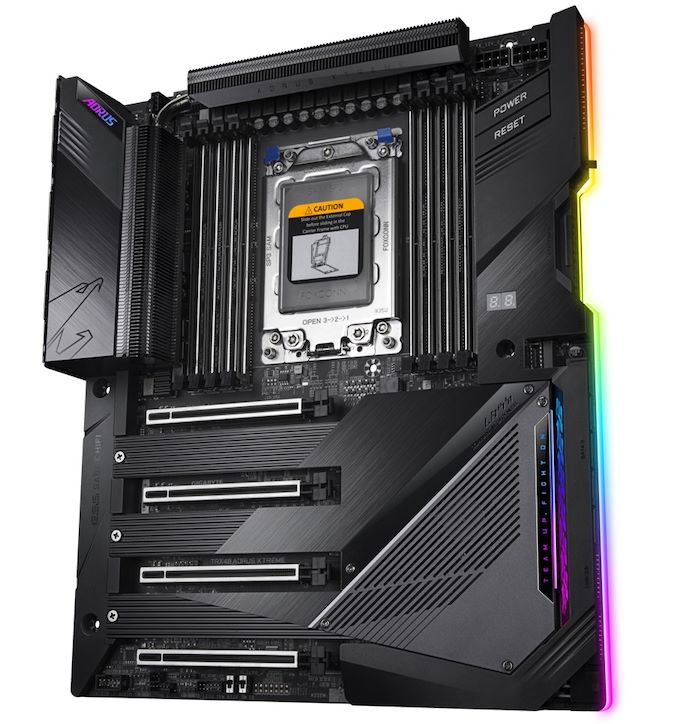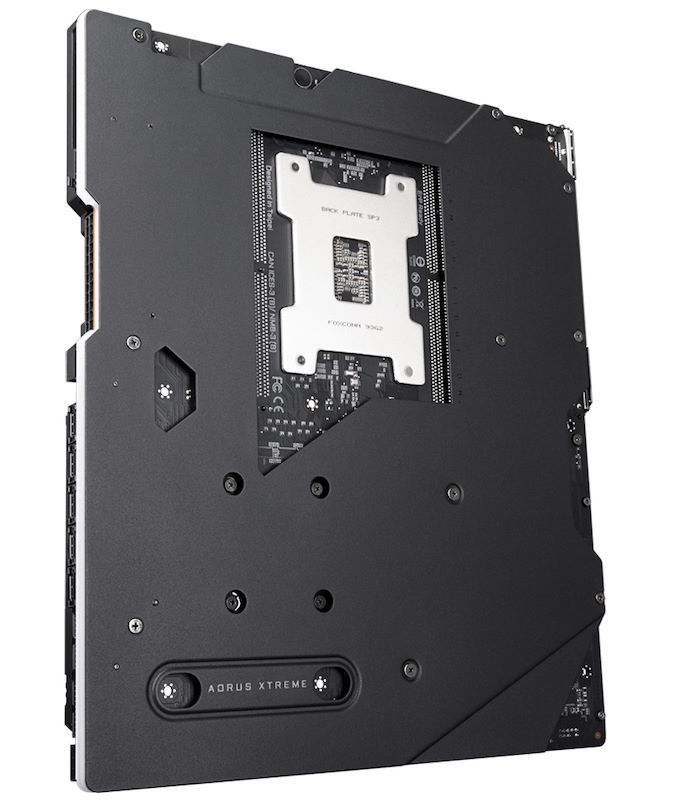The AMD TRX40 Motherboard Overview: 12 New Motherboards Analyzed
by Gavin Bonshor on November 28, 2019 9:00 AM EST- Posted in
- Motherboards
- AMD
- MSI
- Gigabyte
- ASRock
- Asus
- TRX40
- Threadripper 3000
- Castle Peak
GIGABYTE TRX40 Aorus Xtreme
To bolster the release of AMD's Threadripper 3000 series, GIGABYTE has unveiled the largest stack of all the vendors with a total of four new models. Three of GIGABYTE's TRX40 product stack flies the Aorus flag which is its gaming brand, with one model aimed more towards the professional user and content creators.
Starting with GIGABYTE's flagship TRX40 model, the GIGABYTE TRX40 Aorus Xtreme, it shows the potential of what to expect from AMD's new TRX40 chipset. The core feature set is impressive with an Intel X550-AT2 10 GbE dual-port Ethernet controller, an Intel AX200 Wi-Fi 6 wireless interface, and a total of four PCIe 4.0 x4 M.2 slots designed for super-fast NVMe PCIe 4.0 storage devices. Also bundled with the TRX40 Aorus Xtreme is an Aorus Gen4 AIC adaptor card which supports up to four 2 TB M.2 SSDs while benefiting from the bandwidth of PCIe 4.0.
The GIGABYTE TRX40 Aorus Xtreme is an XL-ATX motherboard and has a very unique and distinct look to it with a full coating of black metallic thermal reactive armor which covers the majority of the PCB. Integrated into the design is RGB LED lighting which is incorporated into the top of the rear panel cover, the right-hand side of the TRX40 chipset which features active cooling, and along the right edge of the board. A two-digit LED debug is moulded into the armor to the right of the memory slots, while a power and reset switch is placed just above. Focusing on memory support, the GIGABYTE TRX40 Aorus Xtreme has eight slots which are capable of supporting DDR4-4400 and up to 256 GB in quad-channel mode.
Underneath the rear panel cover and the large heatsink is the monolithic 16-phase power delivery which is controlled by the high-end Infineon XDPE132G5C true 16-phase PWM controller, with sixteen Infineon TDA21472 70 A power stages. This is similar to the design that we saw on the GIGABYTE X570 Aorus Xtreme model and in our testing, it proved to be one of the best and most efficient designs so far. The TRX40 Aorus Xtreme also has four full-length PCIe 4.0 slots which operate at x16/x8/x16/x8. For storage, there are four PCIe 4.0 x4 M.2 slots with its own M.2 heatsink, and a total of ten SATA ports; eight from the TRX40 chipset with RAID 0, 1, 10 support, and two SATA ports from an ASMedia SATA controller.
On the rear of the XL-ATX PCB is a full cover backplate which not only adds extra structural reinforcement to the rear but it also undoubtedly adds extra weight to the motherboard itself. Looking at the board from the rear allows us to see the right-angled 24-pin ATX motherboard power input, which is designed to make cable management look even cleaner. The GIGABYTE TRX40 Aorus Xtreme also includes an OC PEG power connector, an Aorus Gen4 AIC adaptor, and temperature sensor headers for the more extreme users. For cooling, there are seven 4-pin headers in total with one for a CPU fan, one for a water pump, and five for chassis fans.
On the rear panel is seven USB 3.1 G2 Type-A, and one USB 3.1 G2 Type-C port, which is a marked improvement on USB connectivity over the previous TR3 X399 models. To the left is a Clear CMOS button with a Q-Flash Plus button, with a pair of Intel AX200 Wi-Fi 6 antenna connectors and two 10 GbE ports powered by an Intel X550-AT2 10 GbE controller. For the onboard audio, there are two Realtek ALC4050H HD audio codecs with one paired up with a Realtek ALC1220 which powers the five 3.5 mm audio jacks and S/PDIF optical output on the rear, and another for the front panel audio which includes an ESS Sabre 9218 DAC.
The GIGABYTE TRX40 Aorus Xtreme is undoubtedly one of the flagship models on AMD's new Threadripper 3000 sTRX4 socket with a very high-end feature set, and very competent true 16-phase power delivery for the CPU. It's blend premium componentry and elegant stylings aren't going to come without a heavy hit to the wallet, with the GIGABYTE TRX40 Aorus Xtreme expected to cost $849.













109 Comments
View All Comments
HJay - Saturday, November 30, 2019 - link
Life really does begin at 50.HJay - Saturday, November 30, 2019 - link
Your point is valid and I'm not ready to switch from external interfaces to an internal RME unit yet. However, the performance and quality of the peculiar on-board audio arrangement is still of great interest. Experiencing AMD's AM3 FX chipset USB implementation (See: "Silicon Errata for SB950") was rather eye opening and very helpful in understanding why running USB audio across that implementation was less than optimal. The USB arrangement of AM4 seems to be an improvement over the AM3 and AM3+. But AMD's TRX40 seems to reveal a non-satisfactory level of concern for PC audio -suggesting that AM4 might be more appropriate. This motherboard review is a great start but there are still many holes to fill in regarding this, in particular with the S1220.Selecting an appropriate motherboard upfront before throwing thousands of dollars worth of audio software and hardware at it is critical. I did note compatibility issues between earlier AM4 systems and some Universal Audio cards and the desired RME card is around $900. So, I'm just not ready to ride the bleeding edge with these new boards but will eagerly listen to the experiences of others and cheer them along.
As a side note, I did recommend to my favored audio repair software vendor that they contact AnandTech to provide, or work out, some audio benchmarking tests or packages.
Bccc1 - Saturday, November 30, 2019 - link
I still don't get your point. I agree that the USB implementation is important, that AMD messed that up in the past (thanks for the ref to the errata list) and that the way onboard audio works on TRX40 is maybe more error prone.But why is that different / better with the S1220? And how do you define an audio creator? I was thinking of an audio engineer, someone who does tracking/mixing/mastering/sound design. I can't imagine someone in that field would ever use onboard audio, except maybe for mobility reasons on a notebook.
I will probably use my RME Madiface XT with a StarTech USB card (PEXUSB3S44V) as I don't trust any onboard USB.
Regarding the compatibilty issues, do you have links/detailed information? The only thing I found was an issue, where the card wasn't detected in PCIe slots connected to the chipset. Which is a shame, but less of a problem with TRX40 as most slots are directly connected to the CPU.
tamalero - Saturday, November 30, 2019 - link
I'm no expert here but could perhaps say this because of the audio problems of some cpus (crackling cutting) because of the high latency of Ryzen and the first Threadrippers?Or perhaps power issues (delivery to PCIE ports because the big power consumption of the new TR chips?)
Dug - Saturday, November 30, 2019 - link
I think it's time to move past USB if you are a "Real content creator"valinor89 - Friday, November 29, 2019 - link
"The TRX40 chipset is based on the 14 nm process node from Global Foundries""AMD leveraged GlobalFoundries 12nm to build the TRX40 chipset"
Is it 12 or 14?
tamalero - Saturday, November 30, 2019 - link
I remember that Global Foundries is 14nm while TSCM is 14+ (12nm)gavbon - Monday, December 2, 2019 - link
I have corrected it, it is Global Foundries 14 nm process. Thank you for the heads upscineram - Wednesday, December 4, 2019 - link
That's not what Ian said.PopinFRESH007 - Sunday, December 29, 2019 - link
I believe what Ian was referring to is the IO chip on the CPU package which is 12nm.